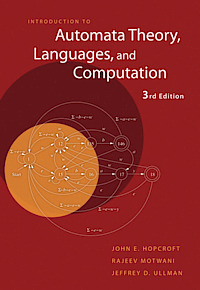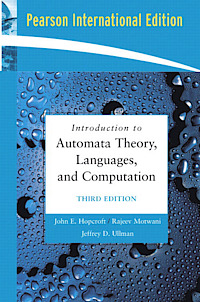Finite Automata Theory and Formal Languages
160830: Exams are now corrected. You can have a look
at your exam at the Student office at CSE department. If you want to
discuss the correction with me (not how many points each answer is
worth!), please send me a mail to book at time. Be aware that a the
grade is modified only if an error in the correction has taken place.
160822: Here is a tentative
solution for the exam on August 17th.
160615: Soon you should be getting the
result of the exam. Student office at CSE department is now closed for
the summer. If you want to look at your exam before the Autumn term
you can pass by my office (room 6116, EDIT-building) on
Wednesday 22/6 10-12.
160602: Here is a tentative
solution for the exam on June 1st.
160524: The protocol from the second
evaluation meeting is now available under the section on course evaluation.
160510: The second evaluation meeting
will take place on Thursday 19th May at 15:00. Please get in touch with
me (Ana) or with any of the course representatives with your comments.
160424: The protocol from the first
evaluation meeting is now available under the section on course evaluation.
160412: The first evaluation meeting
will take place on Thursday 14th April at 15:00. Please get in touch with
me (Ana) or with any of the course representatives with your comments.
160330: The course mailing list has been created. All
students registered in the course before this date should have
received a mail with information on how to access their account.
Those who register to the course after this date need to follow the
instructions under contact information on how
to register to this list.
[top]
At Chalmers: link to TMV027
in the studieportalen.
At GU: Pdf with the description of
DIT321.
[top]
Knowledge in Discrete mathematics and in programming.
Here one can find some short notes to refresh the knowledge on basic
notions like sets, relations and functions. (The responsible of the course
would like to thank Einar Steingrímsson for these notes.)
Note: There are 2 typos in the second page on set theory; the
right most B in the distributive laws (1) and (2) should be an A.
[top]
This course presents both the theory of finite automata, regular
expressions and context-free grammars. It also includes a short
introduction to Turing machines.
Finite automata and regular expressions are one of the first and
simplest models of computations. Their mathematical theory is quite
elegant and simple. Finite automata are widely used in applications
(traffic light, lexical analysis, pattern search algorithm, etc...),
and constitute a perfect illustration of basic concepts in set theory
and discrete structure.
Context-free grammars have important applications in parsing and
analysis of both programming and natural language.
Turing machines were described by Alan Turing in 1937 and they are a
powerful model of computation since they help computer scientists
understand the limits of mechanical computation by providing a precise
definition of an 'algorithm' or 'mechanical procedure'.
[top]
After completion of this course, the student should be able to:
Knowledge and understanding:
- Explain and manipulate the different concepts in automata theory
and formal languages such as formal proofs, (non-)deterministic
automata, regular expressions, regular languages, context-free
grammars, context-free languages, Turing machines;
- Explain the power and the limitations of
regular languages and context-free languages.
Skills and abilities:
- Prove properties of languages, grammars and automata with
rigorously formal mathematical methods;
- Design automata, regular expressions and context-free grammars
accepting or generating a certain language;
- Describe the language accepted by an automata or generated by a
regular expression or a context-free grammar;
- Transform between equivalent deterministic and non-deterministic
finite automata, and regular expressions;
- Simplify automata and context-free grammars;
- Determine if a certain word belongs to a language;
- Define Turing machines performing simple tasks.
Judgement and approach:
- Differentiate and manipulate formal descriptions of languages,
automata and grammars with focus on regular and context-free
languages, finite automata and regular expressions.
[top]
Introduction to
Automata Theory, Languages, and Computation, by Hopcroft, Motwani and
Ullman. Addison-Wesley.
Both second or third edition are fine for the course.
This is how some of the possible versions of the 3rd edition of the
book look like:



ISBN 9780321455369 -- ISBN 9780321476173 -- ISBN 9781292039053
It seems it might be an electronic version of the book that one can
buy from the publisher.
It also seems the electronic copy of the book is available for free through the library.
Observe that the web page of the book contains solutions to some of
the exercises in the book.
Have a look also at Thierry Coquand's note on the
two definitions for the transition function on strings and why they
are equivalent.
Here one can find some short notes to refresh the knowledge on basic
notions like sets, relations and functions. (The responsible of the course
would like to thank Einar Steingrímsson for these notes.)
Note: There are 2 typos in the second page on set theory; the
right most B in the distributive laws (1) and (2) should be an A.
[top]
Since VT13 the examination of the course consists of 2 parts: weekly
assignments valid 1.5 hp (20% of the total hp) and a written exam
valid 6 hp (80% pf the total hp).
One needs to pass both these parts in order to pass the
course.
Since VT15 the final grade in the course is based on the
performance on both the assignments and the exam.
The maximum nr of points to be considered for the final grade is 76: a
maximum of 60 coming from the exam (that is, 100% of the total amount
of points in the exam) and a maximum of 16 coming from the
weekly assignments (that is, 25% of the total amount of the points in
the all the assignments together). In this way the weight of each part
in the course is proportional to the nr of hp in each of the parts in
the course.
The final grade in the course is indicated by the table below where
Final points = nr of points got in the exam + 25% of the points
gathered in the assignment
| Chalmers: |
| Grade | Final Points |
| 3 | 35 |
| 4 | 46 |
| 5 | 57 |
|
|
GU: |
| Grade | Final Points |
| G | 35 |
| VG | 53 |
|
Note: Remember that both parts of the course
need to be passed in order to pass the whole course!!
Example: If a student gets 27 points in the
exam and 32 points in the assignments, then the final points he/she
will obtain are 27 + 0.25 x 32 = 27 + 8 = 35. This student will pass
the assignments with G, pass the exam with G or 3 (depending on the
university), and pass the course with G or 3.
Example: If a Chalmers student gets 36 points in the
exam and 40 points in the assignments, then the final points he/she
will obtain are 36 + 0.25 x 40 = 36 + 10 = 46. This student will pass
the assignments with G, pass the exam with 3, and pass the course with 4.
Example: If a GU student gets 40 points in the
exam and 60 points in the assignments, then the final points he/she
will obtain are 40 + 0.25 x 60 = 40 + 15 = 55. This student will pass
the assignments with G, pass the exam with G, and pass the course with VG.
Older Students
Students who registered before VT13: Since NO re-exams are
offered for that course, these students MUST re-register in the new
version of the course and follow the NEW examination rules.
Students who registered in VT13 or VT14 have obligatory
assignments and the final grade in the course is that of the exam.
Students who registered in VT13 or VT14 and that have NOT
produced any points in the course could re-register in the course in
VT16 and follow the NEW examination rules.
Students who registered in VT13 or VT14 and that HAVE
produced some points in the course MUST follow the
examination rules corresponding to VT13/VT14.
Students who registered in VT15 have exactly the same
examination rules as those registered this year.
Weekly Assignments
There will be 7 assignments and the total amount of points for all
assignments together will be 64 points.
To pass the assignment part of the course one needs to get
at least 50% of the sum of the points of all the weekly assignments
together, that is, one needs to get at least 32 points in total.
Each assignment will be made available not later than 1 week before
the deadline.
For more information about the weekly assignments please visit this page.
Exam
No books or written help during the exam.
Dates of the exams during 2016: 1 June efternoon and
17 August morning.
Check the
studieportalen
for the exam's locations and possible updates.
Grade information: The table below shows the nr of
points one needs to get in the exam in order to obtain a certain
grade in the exam. The total nr of points in the exam is 60.
| Registration Code |
Nr of hp |
Chalmers |
GU |
| TMV027 or DIT321 registered VT13 or later |
6 hp |
3: >=27, 4: >= 38, 5: >= 49 |
G: >=27, VG: >= 45 |
Any exercise in the assignments of this course is a typical exam question.
During one of the last lectures, 2013's exams will be discussed in class
(Exam 130528,
Exam 130821).
See the weekly plan for further information.
Here one can find some older exams: Exam
100527 with solutions, Exam 100827
with solutions and exams from 2007 (one may skip
exercise 13 of the first exam) with solutions
(one should ignore the comments on derivatives in the solutions since
that part was not covered in the course).
[top]
The course should have at least 3-4 students representatives from each
university. The students representatives will meet the responsible of
the course a couple of times during the study period 4. In these
meetings the student representative should write the minutes. The
final meeting takes place after the exam, sometime during the next
study period. Representatives from the IT and GU programmes are
usually present in this last meeting and take notes.
Link to last year's evaluation: Protocol
last meeting 2014/2015.
| Students representatives at Chalmers: |
|
Lage Bergman, mail:
lageb(at)student(dot)chalmers(dot)se |
|
|
Nicklas Lallo, mail:
lallo(at)student(dot)chalmers(dot)se |
|
|
Erik Sievers, mail:
eriksie(at)student(dot)chalmers(dot)se |
|
|
Therese Sturesson, mail:
thestu(at)student(dot)chalmers(dot)se |
| Students representatives at GU: |
|
Johan Berndtsson, mail:
gusberjodo(at)student(dot)gu(dot)se |
|
|
Anders Christiansson, mail:
guschranh(at)student(dot)gu(dot)se |
|
|
Kamil Miller, mail:
gusmilleka(at)student(dot)gu(dot)se |
|
|
Filip Wallden, mail:
guswalfi(at)student(dot)gu(dot)se |
First meeting: Thursday 14th of April at 15:00.
Protocol.
Second meeting: Thursday 19th od May at 15:00. Protocol.
[top]
| Lecturer and examiner: |
Ana Bove,
mail: bove(at)chalmers(dot)se |
| Assistants: |
Pablo Buiras, mail: buiras(at)chalmers(dot)se,
Victor López, mail: lopezv(at)chalmers(dot)se,
Daniel Schoepe, mail:
schoepe(at)chalmers(dot)se
Marco Vassena, mail: vassena(at)chalmers(dot)se and
Andrea Vezzosi, mail: vezzosi(at)chalmers(dot)se |
Feel free to contact any of us, either after the lectures/exercise
sessions or via email.
Course Mailing List
By the beginning of the second week, all those students registered in
the course will be registered to the mailing list of the course
fafl(at)lists(dot)chalmers(dot)se. A mail confirming the
registration and containing log-in information to the Mailman
administrative interface will be sent to each student.
Those students who don't get such mail please visit this page to
register.
Be aware one can only post to the list with the mail address one has
been registered to the list.
Note: The mailing list is being moderated to make
sure that only mails concerning all/many students are sent to the
list.
Questions that only concern a particular students should
be sent directly to me (Ana).
[top]
- Previous year's pages:
2015,
2014,
2013,
2012,
2011,
2010
- Wikipedia
- Short notes on basic notions
like sets, relations
and functions.
(The responsible of the course would like to thank Einar
Steingrímsson for these notes.)
Note: There are 2 typos in the second page on set theory; the
right most B in the distributive laws (1) and (2) should be an A.
[top]


